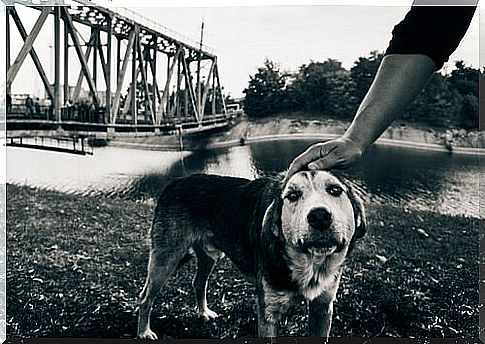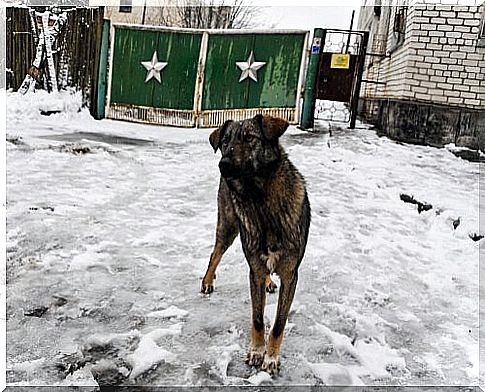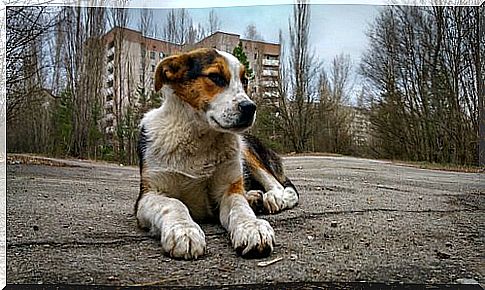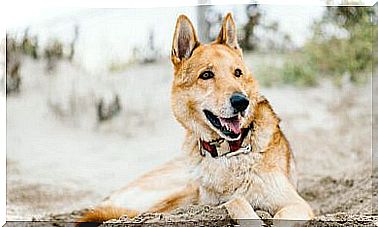Chernobyl’s Last Dogs

Despite human errors that led to the nuclear disaster in central Ukraine – when it was part of the USSR – 300 dogs still live in this region. Most Chernobyl dogs are wild. They only rely on the help of tourist guides who are in the area.
The Chernobyl disaster still remains in the collective imagination of humanity. However, we cannot forget some of its most inspiring survivors. In other words, we are talking about the dogs of Chernobyl.
In 1986, one of the most serious disasters of humanity occurred, the most tragic nuclear accident that humanity has ever suffered. On April 26 of that year, there was an overheating in the Ukrainian plant (when it belonged to the Soviet Union). So, the accident released an amount of radiation 500 times greater than that of Hiroshima.
The Chernobyl disaster killed 31 people directly and caused a sudden evacuation of over 100,000 people. In addition to establishing a containment plan that isolated an area of 30 kilometers from the nuclear plant. Despite this, millions of people live in areas with a greater or lesser degree of contamination.
Chernobyl, a wildlife refuge?
Although today there is a massive 30,000-ton structure that isolates the crash site, there is an exclusion area known as the alienation zone, where only a few people live illegally, but where biodiversity appears to be returning.
After the disaster, around the plant, the pine trees died and turned red and gold. Therefore, the region was named after the red forest. In the case of fauna, many animals died or lost a large part of their reproductive capacity. Despite this, years later, this forest ended up becoming a haven for wildlife.
Thanks to the fact that human activity has disappeared, wild animals have returned and it is even considered declaring the site a nature reserve. The truth is that, despite the disaster, in the long term, there was an increase in biodiversity in the area. As incredible as it sounds, endangered bears, lynx, wolves and birds of prey reclaimed their territory when humans ceased to occupy the place.

Although it may seem strange, most of these animals have a short life expectancy and malformations that prevent their reproduction. Some changes produced by radiation are surprising, such as changing patterns in spider webs.
The harsh conditions of the dogs of Chernobyl
However, there are more animals that have taken to the old streets devastated by the nuclear disaster, especially dogs. Those descendants of dogs who were not allowed to leave the contaminated area managed to survive and reign among the ashes.
Conditions are not easy either. There are the high levels of radiation that reduce the fertility and life expectancy of these animals. Furthermore, there is a lack of shelter to survive the harsh winters that hit this region of Eastern Europe. Most Chernobyl dogs are under six years of age due to radioactive debris in their bodies.
In fact, many animals were sacrificed after the catastrophe. However, some managed to survive. H oday, is estimated to be in an area 2,600 square kilometers there are more than 300 wild dogs. Practically, the dogs of Chernobyl outnumber the inhabitants, so most of them are ownerless.
The guides, the hope of the dogs of Chernobyl
Fortunately, the dogs are supported by guides and the region’s scarce tourist infrastructure. Therefore, they are close to any of the cafes that take advantage of the tourist attraction of this historic point in Europe.

Tour guides have also established small animal shelters. These places become small oases where dogs have scraps of food and a roof to spend the harsh Ukrainian nights. Still, these people lament that there is no more humanitarian collaboration to help these animals.
A future for the dogs of Chernobyl
Some NGOs, such as the Clean Futures Foundation, help these animals by establishing veterinary clinics to vaccinate these dogs against diseases such as rabies or parvovirus. One of them was established on the premises of the old plant. This allows the few inhabitants of the region to take their animals, in addition to taking care of stray dogs.
They are also neutering dogs to maintain birth control on these animals. After all, they cannot be rescued from the area because of the risk they pose to human health, if more dogs are born, they will be condemned to live in these conditions. So the ultimate goal is that there are no dogs wandering around Chernobyl.
Unfortunately, it appears that animals are also affected by this type of disaster. Despite this, there are still people who seem to care that the dogs of Chernobyl can continue to live happily and on food.








